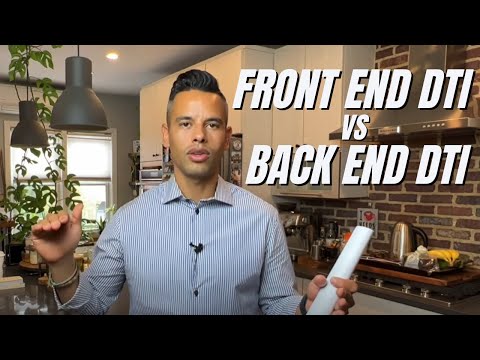Understanding the Front End Ratio in Mortgage Lending
Let’s break the ice and dive right into what’s cooking in the mortgage world. Picture this – you’re eyeing that dream home but before you can say ‘white picket fence’, there’s a financial gatekeeper to impress: The Front End Ratio. The front end ratio, my friends, is one slice of the pie lenders nibble on while deciding if you’re a shoo-in for a loan.
So why’s this ratio got everyone talking? Well, the front end ratio is like your financial first impression – it tells lenders whether you’ve got the chops to handle your would-be housing bills without breaking a sweat. Back in the day, this humble ratio was less of a heavyweight, but as the housing market’s ebbs and flows have turned into tidal waves, lenders have given the front end ratio a front-row seat in the loan approval process.

Delving into the Mechanics of Front End Ratio
The front end ratio, or what’s known by some as the housing ratio, is a financial detective, revealing what chunk of your paycheck will go to your housing costs. Here’s how it juggles the numbers: Take your potential housing expenses (yes, this includes that mortgage payment, taxes, and insurance), and divide them by your gross monthly income. Voilà, you’ve got your ratio!
Now, this isn’t a fixed race—you’ve got different horses for different courses. Back in the golden oldies of mortgage underwriting, the standard front end ratio could be more forgiving, but today, the aim of the game is keeping it under 28% for most loans, and 31% or less if you’re flirting with an FHA loan.

| **Aspect** | **Details** |
|---|---|
| Definition | The front-end ratio, or housing ratio, is the percentage of monthly gross income dedicated to housing costs. |
| Components | Housing expenses include mortgage payment, property taxes, homeowners insurance, and homeowners association dues. |
| Ideal Ratio | Preferred by most lenders: ≤ 28% |
| FHA Loan Ideal Ratio | Preferred: ≤ 31% |
| Back-end Ratio Link | Typically, lenders look for a back-end ratio (all monthly debts) of ≤ 43%. |
| General DTI Suggestion | Advised to be below 43%, with ≤ 35% viewed as “good”. |
| Calculation | Monthly housing costs divided by gross monthly income. |
| High Ratio Implication | Higher than recommended ratios indicate increased risk of default. |
| Credit Score Exception | Borrowers with good credit may be allowed ratios up to 50%. |
| Common Requirement | Some lenders may use a 28/36 ratio requirement (front end/back end). |
| FHA Loan Requirement | Front-end ratio limit is often 29%, with the back-end ratio at 41%. |
| VA Loan Ratio Focus | VA Loans consider only the back-end ratio, which must be 41% or lower. |
| Importance of Front End | Indicates borrower’s ability to manage housing cost within their income. |
| Risk for Lenders | Higher front-end ratio presents a greater risk for the lender. |
| Application Assessment | Lenders use this ratio to determine mortgage affordability for applicants. |
The Role of Front End Ratio in Evaluating Borrower Eligibility
Front and center of the lending stage, the front end ratio is like the bouncer assessing if you can enter the loan approval club. Lenders lean on this figure to suss out if you’re biting off more than you can chew with a mortgage. Get this, a high front end ratio can send red flags waving, while a low one gives off the vibe that you’re playing it safe. The stats suggest that applicants with a front end ratio that stays below the magic numbers—28% for traditional loans and 31% for FHA—are more likely to see their loan approved.

Front End Ratio Vs. Back-End Ratio: A Detailed Comparison
Roll up your sleeves, because we’re about to get into the nitty-gritty of the front end ratio and its sibling, the back-end ratio. While the front end ratio homes in on your housing debts, the back-end ratio takes a gander at all your monthly debts. Together, they paint a Picasso of your financial portrait, with lenders aiming for a balanced back-end of no more than 43%.
Imagine two sides of the same coin; maintaining a healthy front and back-end ratio duo is akin to walking a financial tightrope with finesse. Case studies show those juggling both ratios well tend to land on their feet with better loan deals.

Expert Insights on Optimizing Your Front End Ratio
Want to be the head honcho of your front end ratio? Start by trimming the fat off your housing expenses. It might mean scouting for a modest abode or playing hardball in negotiation arenas. Mortgage maestros suggest that a well-managed housing expense is a golden ticket to sweet loan terms. According to recent analysis, fine-tuning your front end ratio can lead to a domino effect, potentially easing up your interest rates and down payment blues.

The Future of Front End Ratio in a Dynamic Housing Market
The housing market is a wild rollercoaster, and just like a young Larry david, it’s full of surprises. The current market pulse suggests that changes in housing ratio standards reflect the broader economy’s ups and downs. With home prices on the moonwalk and salary increases doing the slow shuffle, expect lenders to calibrate their front end ratio preferences.
Looking ahead, new regulations might just rewrite the script on front end ratio requirements, keeping lenders and borrowers on their toes. Stay tuned; this drama is far from the final act.
Real-world Scenarios: Navigating Front End Ratio Challenges
Real talk—everyone loves a good comeback story. Imagine the borrower who faced front end ratio odds stacked higher than a pancake tower, only to come out on top with a lender’s green light. We’ve chatted with lenders who’ve seen it all, from clients waltzing in with ratios as high as 50% and still locking in loans, to financial wizards helping course-correct an unfavorable front end ratio through savvy counseling.
Technology’s Impact on Understanding and Monitoring Front End Ratios
Enter the age of tech, where apps and tools aren’t just for playing Vrbo Vs Airbnb. They’re revolutionizing how we track our housing ratio. Artificial Intelligence is now slipping into the mix, crunching numbers to forecast front end ratio trajectories. This tech wave isn’t just making waves; it’s a full-on tsunami changing how we view and improve our front end ratio game.
Unveiling the Connection Between Front End Ratio and Loan Terms
Time to dive into some heavy-hitting data analysis. The front end ratio doesn’t just knock on the door of loan terms; it moves in and rearranges the furniture. A cuddly front end ratio can mean cozier interest rates and a down payment that doesn’t leave you reeling. Delving into different loan products reveals that there’s wiggle room when it comes to front end ratio limits, but it’s often akin to finding extra space in a cluttered closet.
Beyond Ratios: Additional Factors That Influence Loan Approval
But wait, there’s more! Besides front end ratio, lenders peek at other numbers like credit score, job stability, and cash reserves. Think of it as a puzzle where the front end ratio is just one piece. Financial probity is a kaleidoscope, and the front end ratio is just one of the many colors.
The Art of Front End Ratio: Crafting the Path to Homeownership
Alright, let’s tie it all together now. We’ve journeyed through the serpentine paths of front end ratio enlightenment to mastery. Remember, handling the front end ratio with poise is akin to holding the key to your future home’s front door. Keep these strategies tucked under your hat, and walk the path to loan approval and financial stability with your head held high.
There’s a veritable smorgasbord of tactics, tools, and twists to tango with when it comes to front end ratios. By wrapping your head around this pesky yet pivotal piece of the mortgage puzzle, you’re not just crunching numbers—you’re crafting your very own path to homeownership.
In the end, it’s not just about ratios; it’s about readiness. So, gear up, future homeowners. With a solid grip on the front end ratio and the willingness to adapt to the dynamic financial terrain ahead, get ready to dot the i’s and cross the t’s on that dream home purchase agreement. Welcome to the homeownership club—front end ratio decoded, demystified, and dominated.

What is a good front-end ratio?
Ah, you’re eyeing that sweet spot for a front-end ratio, huh? Well, a good one typically hovers around 28% or less. That’s sort of the golden number where lenders nod approvingly, thinking you’re not biting off more mortgage than you can chew.
How do you calculate front-end ratio?
To crunch those front-end ratio numbers, just take your projected monthly mortgage payment (that’s including taxes, insurance, all that jazz), and divide it by your gross monthly income. Voilà! You’ve got your ratio, quick as a bunny.
What is a good DTI ratio?
When it comes to DTI ratios, they say less is more, and boy, isn’t that the truth? Lenders usually like to see a DTI ratio under 36%—that’s with all your debts on the line, not just the new house you’re eyeing.
What are the limits for front and back end ratio?
Limits for front and back-end ratios? You betcha. Lenders typically prefer a front-end ratio under 28% and a back-end ratio less than 36%. Of course, there might be some wiggle room, but that’s walking the tightrope without a net.
Can I get a mortgage with 55% DTI?
Can you snag a mortgage with a 55% DTI? It’s a long shot, to be honest. Lenders might raise an eyebrow or two because that’s kind of pushing the envelope. However, some loan programs, like FHA, might still consider you, but it’s no walk in the park.
What is an acceptable front-end DTI?
An acceptable front-end DTI? Think of it as keeping your front yard nice and tidy—most lenders like it to be 28% or less. It shows you’re not stuffing your mortgage till the garden’s overflowing!
What is the 36 rule?
Ah, the 36 rule—it’s like the unwritten law of the lending land. It’s the idea that your DTI ratio shouldn’t exceed 36%, keeping your financial ship sailing smoothly without too much debt to rock the boat.
What is the 28 front end ratio?
When folks talk about the 28 front-end ratio, they’re not discussing their latest diet. Instead, they mean that your monthly mortgage payment shouldn’t gobble up more than 28% of your monthly income before taxes. Keep your housing diet lean, right?
What minimum credit score do most lenders require?
When it comes to the credit score hustle, most lenders typically want to see at least a 620 on your scorecard. But remember, the higher, the better—those top-notch scores can snag you the best rates.
What are the 4 C’s of mortgage underwriting?
The 4 C’s of mortgage underwriting—it’s not a new boy band, but the criteria lenders use to judge if you’re worth the risk: Credit, Capacity, Capital, and Collateral. Nail these and you’re on your way to homeownership glory.
Is 38% DTI too high?
Is a 38% DTI staring you down? It’s a bit up there, on the high side of the comfort zone. Lenders might be squinting at that, wondering if you’ve got enough left in your wallet at the end of the month.
What is considered monthly debt when buying a home?
In the home-buying world, ‘monthly debt’ is basically everything but the kitchen sink—your credit cards, car loans, student loans, child support, you name it. If it’s a regular bill, it’s tagging along with your DTI ratio.
What is the maximum front-end ratio for a FHA loan?
For those fancying an FHA loan, they stretch that front-end ratio limit up to 31%. It’s a bit more breathing room for your mortgage appetite, but don’t go overboard.
Is 37 debt-to-income ratio good?
Is a 37% debt-to-income ratio good? Eh, it’s not setting off fireworks. While it’s not in the danger zone, it’s kinda like treading water—you’re afloat, but it wouldn’t hurt to trim the fat a bit.
What is the 28 front-end ratio?
You caught us! The 28 front-end ratio has made an encore appearance. Quick recap: it’s your monthly mortgage payment not taking more than 28% of your pre-tax income for a harmonious financial household.
What is the 28 36 Rule of debt ratio?
Finally, the 28/36 rule of debt ratio is like the buddy system for your finances—spend no more than 28% on housing and keep total debt under 36%. Stick to these buddies, and you’re playing it safer than staying home on a Friday night!



